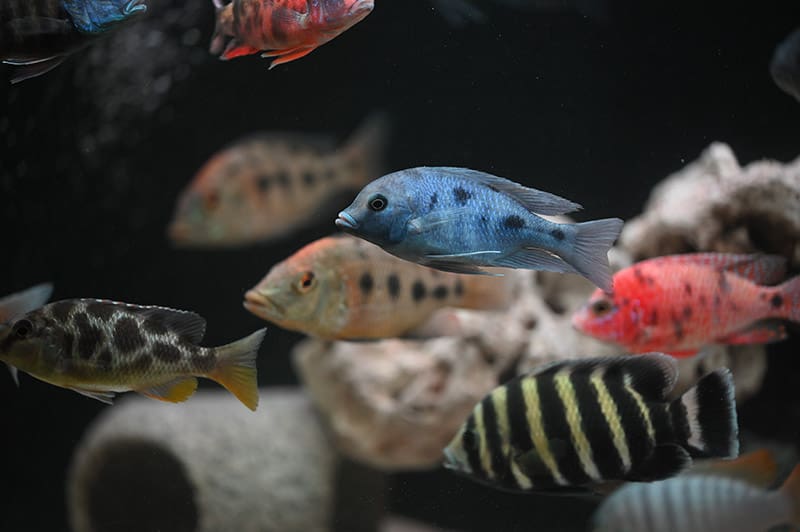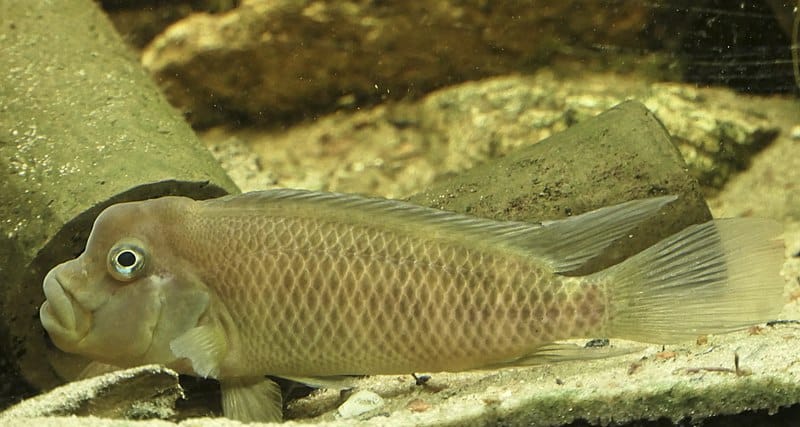There are many wonderful African cichlids that you may run across in the aquarium hobby besides the popular species found in Lake Malawi or Lake Tanganyika.
There are several hundred vibrantly beautiful species of cichlids found in Lake Victoria alone, an estimated 200. There are also numerous attractive East African Cichlids from surrounding lakes and waterways, as well as a number of West African Cichlid species.
The African Cichlids are renown for their diversity and beauty, and for their fascinating behaviors. As the cichlid species evolved, they successfully exploited every conceivable way of life in the lakes and streams. There are several hundred vibrantly beautiful species of cichlids found in Lake Victoria alone.
Cichlids became adept at inhabiting moving waters, rocky areas, sandy shores, and open water (pelagic) regions. The simple term “African Cichlid” is anything but simple. There is a great diversity in the each of the cichlid genera and in their habitats. Yet all these cichlids make fascinating aquarium inhabitants.
Lake Victoria Cichlids, West African Cichlids, and other East African cichlids offer aquarists a delightful experience. They are enjoyed for beauty as well as interesting behaviors and personalities. They are quite active, displaying complex behaviors, and with the right environment many can be bred in captivity.
- To learn more about all types of African Cichlids, see: African Cichlids – Fish Information and Cichlid Care for African Cichlids
Cichlid Habitats
Lake Victoria is one of the great lakes of Africa. It is the third largest lake in Africa but unlike Lake Malawi and Lake Tanganyika, it is not a rift lake. It is a “younger” lake than the other two and though it is also very large it is not a deep rift lake. Rather it is a shallower, saucer-shaped lake that lies between the two rift lake valleys.
The waters of Lake Victoria are known for clarity and stability as far as pH and other water chemistries. This lake is primarily filled through precipitation (80%) but also has numerous of streams with a high mineral content flowing into it. The high mineral content along with evaporation resulted in the lake having alkaline water that is highly mineralized. With the high level of dissolved minerals, the water is also very hard.
The regions that cichlids inhabit in Lake Victoria include rocky areas, sandy areas, and midwater areas, or they can be a combination of two or all three of these types. Other East African Cichlids inhabit surrounding lakes with similar habitats. East African as well as the West African Cichlids are also found in other waterways – rivers and streams, and some in coastal areas.
Types of Cichlids
African Cichlids range from the energetic rock-dwelling cichlids, free-swimming types that inhabit sandy areas and open waters, and cichlids from the moving waters of rivers and streams. With this vast quantity of species and a variety of habitats, there is much diversity. These cichlids include those from Lake Victoria, East African Cichlids, West African Cichlids, and African Dwarf Cichlds.
Some Lake Victoria Cichlids and other East and West African Cichlids include:
- Kribensis Cichlid Pelvicachromis pulcher
- Lionhead Cichlid Steatocranus casuarius
- False Mpozo Lionhead Cichlid Steatocranus glaber
- Nanochromis transvestitus Nanochromis transvestitus
Lake Victoria Cichlids
There are several hundred vibrantly beautiful species of cichlids found in Lake Victoria alone, though it is comprised almost entirely of endemic species of Haplochromines along with a few Talapines. Cichlids from Lake Victoria have not been introduced into the hobby as intently as those from Lake Malawi and Lake Tanganyika, consequently they have not become as well known.
There is a large reduction in the number of cichlids from Lake Victoria today. The Lake Victoria area is one of the most densely populated places in the world. Human activities have a tremendous impact on the ecosystem and are greatly accelerating biological changes to the lake. They are also being impacted by the introduction of the Nile perch Lates niloticus, a voracious predator.
Unfortunately there are not many Lake Victoria cichlids available today. Only a few species, primarily those known as ‘mbipi’ a rock dwelling cichlid counterpart to Lake Malawi’s Mbuna Cichlids, are sometimes available. Some Lake Victoria cichlids, like the Astatotilapia genus, have been breed in aquariums so are more readily available.
Cichlids from Lake Victoria Cichlids found in the hobby include species from these genera: Astatotilapia, Pundamilia, Mbipia, Pseudocrenilabrus, Haplochromis, Neochromis, Paralabidochromis, Ptyochromis, and Platytaeniodus.
East African Cichlids
Other types of cichlids include cichlids found in lakes surrounding Lake Victoria. Some of these are not found in the lake regions; rather they are native to African rivers and streams, and live in a wide variety of habitats. Plus there are also a number of cichlids from outlying islands east of Africa, including Madagascar.
Cichlids from this group found hobby include these genera: Astatoreochromis, Astatotilapia, and Lithochromis.
West African Dwarf Cichlids
Many West African cichlids are native to African rivers and streams and live in a wide variety of habitats. These include a number of African Dwarf Cichlids that are interesting and beautiful little fish. A favorite is the popular Kribensis or Krib Pelvicachromis pulcher.
African Dwarf Cichlids include species from these genera: Pelvicachromis, Nanochromis, Steatocranus, Benitochromis, Pelmatochromis, Thysochromis, Chromidotilapia, and Tilapia.

African Cichlid Tanks
The size of the aquarium varies from species to species, and how many fish you wish to keep. For many species a minimum of 10 gallons will work for a pair, 20 gallons for a group, and 55 gallons or more for a community type tank will suffice. However if you wish to maintain larger species, a larger will be required. A good rule of thumb is approximately ½ “ (12 mm) of fish per gallon (4 L).
Like all cichlids, Lake Victoria Cichlids and other African Cichlids are naturally aggressive fish. When placed in the confines of an aquarium you may see an increase in aggressive behavior. This is especially true if the aquarium is too small, and if there is inadequate places of refuge to avoid an aggressor. Planning ahead can help avoid problems of predation, aggressive incompatibility, and even hybridization.
It helps to determine in advance the types of cichlids you are going to keep and then choose and appropriate sized tank and decor. Different types of cichlids can often be housed together as long as each type is provided with its appropriate environment to make these cichlids feel more at home. For example, an open area in the upper region is needed for energetic open water swimmers. Provide lots of rocks and cave formations for rock-dwelling types. Sand dwelling types like to have a few smooth rocks to help define their territories, and so forth.
African cichlids can be fed frozen or live brine shrimp, mysis, high quality flake, pellets, spirulina, and other preparations for omnivore cichlids. It is always better to feed them small amounts several times a day instead of one large feeding.
See each individual species for in-depth information along with specific care and feeding requirements.
Steatocranus casuarius (Image Credit: 5snake5, Wikimedia Commons CC0 1.0 Universal)
